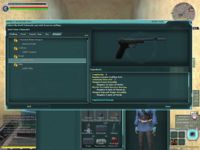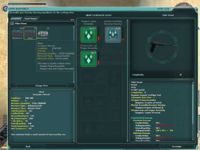Difference between revisions of "Crafting Tool (Game Mechanics)"
(→Crafting Stage 2) |
|||
| Line 236: | Line 236: | ||
|valign="top"| | |valign="top"| | ||
| − | |||
Revision as of 08:20, 6 March 2008
| This article or section needs proper wiki formatting. |
Game Mechanics - Mechanics Category
SWGANH Wiki is a repository of Star Wars Galaxies Developer information. This site is only meant to be used by SWGANH Developer team.
|
|
OverviewTypes of tools
There are three types of crafting tools, Generic Crafting Tools and Specialized Crafting tools and Lightsaber crafting tools. The Generic Crafting Tool is the most basic crafting tool you will use. It's the key to making the items you want to make. All beginning crafters start with this tool. Specialized crafting tools consist of five different types with these being the Food and Chemical, Clothing and Armor, Structure and Furniture, Weapon Droid, and General Item, and the Starship Crafting tools. These must be constructed by a crafter using a generic tool. The chief differences between these tools is that item experimentation is not allowed on items created using a generic tool where as it is allowed while using a specialized tool. Another difference between these types of tools is the number and types of items allowed to be created. Specialized tools allow for all items of a certain type to be created, while disallowing items of other types to be created using this tool. For example a food and chemical crafting tool only allows the creation of items that are foods or chemicals, such as those given as schematics in the chef and medic skill lines. Weapon, Droid and General Item crafting tools allow a player to create and experiment upon some items available to the generic tool, as well as weapons and droid items. A player cannot use a crafting tool if they do not have schematics for that particular tool.
Creatures (Food & Chemical Tool)
Special Note 2: These tool/tab pair ups only show the general types of items found under these. All tier items are usable by specialized tools and all items of complexity 1-15 within each given category where a generic crafting tool is listed are usable by the generic tool.
Item Complexity
Item complexity is a value given to every schematic of which affects the length of time for craft tool and factory production as well as determining which schematics the player can use or not with any given tool. When an item goes through the full crafting process and is completed, the crafting tool will take an amount of time equivilant to 2 x complexity of schematic as the total number of seconds that will pass before the item is created as a prototype from the crafting tool. For factories this timer is 8 x complexity of schematic and determines the total time that it will take in seconds for each item to be produced and deposited into the factory output hopper. Item complexity's effect on the selection of available schematics comes in the following manner. These schematics only show up to the player in the crafting tool if they meet the appropriate qualifications. Item schematics are broken down into 3 categories. The first category are those schematics that can be used with a generic crafting tool. These incorporate all schematics that range from complexity 1 to 15. The second category are those schematics that can be used with only a specialized tool. These schematics range from complexity 16-20. The third grouping of schematics are those that require a specialized tool and at least a public crafting station (those found in npc cities or ranger camps). These schematics range from 21 to 25. The fourth and last grouping of schematics are those that require a specialized tool and a private (player crafted) crafting station. For clarification, all lower tiered schematics can be used by the next highest tier. This means that schematics from 1-20 can be used with just a specialized tool, 1-25 complexity can be used at a public station with a specailized tool, and a private station with a specialized tool can use all schematics.
When a character wishes to begin crafting and has the proper schematics and resources available, they may begin the crafting tool process which is broken into 6 unique stages.
Crafting Stage 1Stage 1 begins with a list of usable/viewable schematics. After selecting the appropriate schematic,the player clicks on on next to continue to the next stage or exit to abort the crafting process all together.
Crafting Stage 2This window has two important sections. The first is a view of your inventory, filtered to show only the resources that can be used to make the item you have chosen. If a resource does not show up in this panel then it's off no use to you at the moment. The main panel in the center shows you the components that you must make with resources in your inventory.
The Assembly screen allows you to place components into your schematic. When you open a schematic, your available resources and components will appear in a window on the left side of the screen. Each schematic has "slots" for specific components. When you click on an available component or resource, any slots that can hold that type of component will glow green. On the left side of the window there is an option to filter contents within the inventory. This toggles whether or not the player wishes to see all items within their inventory on that list or if they wish to only see items that are usable in the schematic. Also on this window is a tab at the top left for the Input Hopper. The input hopper is basically another container from which the player may have access to in order to allocate resources/components from and put into the resource slots directly. You can also access the input hopper by standing within 6 meters next to a crafting station. To access the hopper you will need to open the crafting tool by bringing up the radial menu of a matching crafting tool (a Weapon, Droid, and General Item for example); hover the mouse over "Start crafting" and after a second, you'll see "open input hopper". This brings up another window representing the hopper, and you can drag resources into it from your inventory. Once you've put resources in, you can use them by using the "Hopper" tab during the resource selection step of crafting (assuming you're close enough to the station). Only people with admin rights to the house can access the hopper. So your friend would be able to put resources in and take resources out, and (if he's a crafter) can use the resources during his crafting session. People without admin access to the house get a "you do not have rights to access the hopper" message if they try. Click and drag components into the appropriate schematic slots or double-click on the components to allow the crafting device to automatically assign them to an appropriate slot. Like characters, each resource and component has its own set of attributes that directly affect the quality of the object you're crafting. Some metals are more durable than others, for example. Putting a very durable metal into a blaster schematics likely to result in a very durable blaster. After assigning components to a schematic, click on the Assemble button, Once you have clicked on Assemble, you will attempt to construct the item. Whether or not you can successfully build the item depends upon your skills and the item's complexity. If you suffer a critical failure, you won't complete the item (although resources and components are not lost as of publish 13.1). Crafting Stage 3Assuming you were successful at your crafting attempt, you will receive a message when your item is complete. Unless your inventory is full, the item will be transferred there. If your inventory is full, the item will be stored in the output hopper of the crafting tool. You can access the hopper by holding down on the "Start Crafting -> Open Input Hopper -> Get Finished Prototype" option from the tool's radial menu until "Open Output Hopper" appears.
Item ComplexitySource References |

